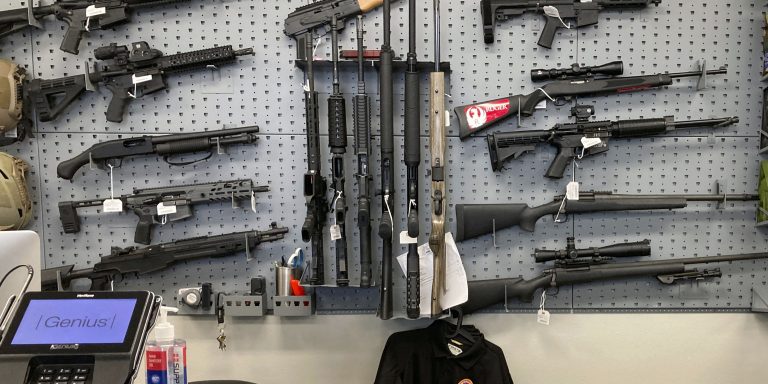INTELBRIEF
June 3, 2022
IntelBrief: The Sad Banality of American Gun Violence

Bottom Line Up Front
- The May 24, 2022, school shooting in Uvalde Texas left 19 schoolchildren and two teachers murdered, highlighting yet again, the United States’ gun violence crisis.
- From police response to school doors, politicians, lawmakers, and lobbyists drive a discussion that refuses to deal head on with the issue of gun violence.
- This U.S. self-harm has real world national security implications and America’s rivals are keenly aware of this fact.
- There will likely be no meaningful action taken on reducing the number of guns flooding American streets and consequently there will be more and more mass shootings.
The individual who murdered 19 elementary school children and two of their teachers on May 24, 2022, at Robb Elementary School in Uvalde, Texas is responsible for his actions and crimes, as are all the shooters who have attacked the American public in recent years. Simultaneously, however, the United States as a whole, represented by elected officials, is responsible for its apathetic response to these crimes, crimes which occur so often they have become tragically banal. In 2012, a gunman killed 20 elementary school children and six adults at Sandy Hook Elementary in Newtown, Connecticut, and the U.S. federal government did nothing to address the one thing that separates the U.S. from all other high-income countries as it relates to these shootings—the widespread availability of high-powered, high-capacity firearms. Unsurprisingly the killings continued: 49 people murdered in an Orlando club in 2016; 58 people murdered at a Las Vegas festival in 2017; 17 people murdered at Stoneman Douglas High School in Parkland Florida in 2018; 22 people murdered at an El Paso Walmart in 2019. These mass-casualty shootings generate massive but short-lived media attention. As demonstrated by the Orlando and El Paso attacks, media attention tends to persist only in cases where political or ideological motives are readily apparent, allowing the public narrative to focus on terrorism rather than gun safety. Annually, tens of thousands of people die across the country by gunfire (including homicide, suicide, and accidents). In 2020, more than 45,000 were killed by firearms in the United States.
The increase in gun deaths is inextricably linked to the increasing number of guns on American streets and in American homes. In the wake of mass-shootings, opponents of gun safety legislation are quick to highlight issues like mental health, violent video games, and declining church attendance as drivers of violence. These arguments dismiss the one constant in every gun death or injury: the gun itself. Mental health crises are not unique to the United States. Citizens of every G7 country regularly play violent video games and church attendance has been declining in Europe for decades, yet no other country experiences the same kind of mass-violence that the U.S. public is subjected to. Only in the U.S. are high power, high-capacity firearms so readily available. There are approximately 20 million of these semi-automatic rifles (commonly referred to as AR-styled rifles). In a country of nearly 333 million, there are more than 393 million guns in private hands, and millions more are sold every year.
In the Uvalde massacre, there is understandable criticism and concern over the inept police response. Sadly, because of the regular occurrence of mass shootings, and of school shootings in particular, the universally accepted best practice for local law enforcement responding to an ‘active shooter’ is never to hesitate, but instead to immediately engage the shooter. In Uvalde, police officers on scene waited more than 50 minutes outside the locked classroom where the gunman continued to kill children, wasting precious time in which injured children could have received lifesaving medical treatment. There are now multiple ongoing investigations into the inexplicable police response.
Because gun violence is directly tied to guns and guns have become intensely political in the U.S., there will likely be no effective federal response to the national security issue of gun violence in the United States. This will continue a decades-long trend of the U.S. government doing nothing in response to a persistent level of gun violence and death that make the United States a statistical outlier, American exceptionalism in the worst possible way. This U.S. self-harm has real world national security implications and America’s rivals are keenly aware of this fact. Russia and China regularly employ grim statistics associated with U.S. mass shootings in attempts to undermine America’s image abroad. Russia aligned cybergroups have also used the controversy surrounding gun safety to sow domestic unrest within the U.S. and divide the American electorate ahead of elections. Experts have also argued that the illicit flow of American firearms into Central America has fueled violence there, exacerbating the migrant crisis along America’s southern border. These painful episodes have also served as cautionary tales for leaders of America’s allies and partners. Just this week, Canada’s Prime Minister Justin Trudeau proposed sweeping restrictions on firearm ownership. In spite of all this, the U.S. Supreme Court recently ruled that almost any restriction on gun ownership, to include open and concealed carry and unregulated magazine capacity, runs afoul of the U.S. Constitution’s second amendment, allowing states to further loosen regulations on gun ownership. Without a change in policy, the complete ubiquity of guns across the U.S. will continue to manifest itself in persistent and staggeringly high rates of gun violence and death across the United States.